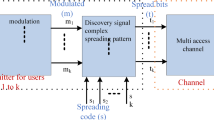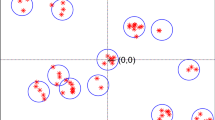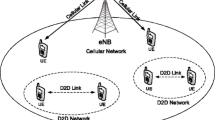Abstract
In device-to-device (D2D) environments where a number of wireless nodes are connected in ad hoc mode, the most popular mechanism for multiple access control is CSMA/CA as in IEEE 802.11 networks. Consequently, a considerable number of hidden terminals can be found in large-scale and dense D2D networks, and usually they may cause severe performance problems. Previous studies to improve the hidden terminal problem in dense wireless networks have suggested various solutions: e.g., channel assignment, transmit power control, and grouping schemes. In this paper, we adopt a different approach—a hidden terminal aware clustering mechanism, which detects the hidden terminals and enables the nodes to form clusters based on the detected information. A simple polling-based channel access scheme is also proposed such that all nodes belonging to a same cluster can access channel through their neighbors’ polling, which eliminates the hidden terminal problem. Mathematical analysis and simulations show that our proposed scheme significantly improves the performance of large-scale D2D networks.













Similar content being viewed by others
References
Asadi, A., & Mancuso, V. (2013). WiFi direct and LTE D2D in action. In 2013 IFIP Wireless Days (WD) (pp. 1–8) IEEE.
Camps-Mur, D., Garcia-Saavedra, A., & Serrano, P. (2013). Device-to-device communications with Wi-Fi Direct: Overview and experimentation. IEEE Wireless Communications, 20(3), 96–104.
Liu, K., et al. (2016). Development of mobile Ad-hoc networks over Wi-Fi direct with off-the-shelf android phones. In 2016 IEEE International Conference on Communications (ICC) (pp. 1–6) IEEE.
IEEE 802.11-2012. Part 11: Wireless LAN medium access control (MAC) and physical layer (PHY) specifications. IEEE (2012).
Wang, X., Derakhshani, M., & Le-Ngoc, T. (2014). Self-organizing channel assignment for high density 802.11 WLANs. In 2014 IEEE 25th annual international symposium on personal, indoor, and mobile radio communication (PIMRC) (pp. 1637–1641) IEEE.
Deng, D.-J., Chen, Y.-S., & Wong, Y.-S. (2013). Adaptive channel allocation strategy for mobile ad hoc networks. Mathematical and Computer Modeling, 57(11–12), 2720–2730.
Lei, X., & Rhee, S. H. (2015). Performance enhancement of overlapping BSSs via dynamic transmit power control. EURASIP Journal on Wireless Communications and Networking, 2015(8), 1–8.
Marchanga, J., Ghita, B., & Lancaster, D. (2017). Location based transmission using a neighbor aware with optimized EIFS MAC for ad hoc networks. Ad Hoc Networks, 63, 62–78.
Chau, C.-K., et al. (2017). Effective static and adaptive carrier sensing for dense wireless CSMA networks. IEEE Transactions on Mobile Computing, 16(2), 355–366.
Lei, X., & Rhee, S. H. (2016). Improving the IEEE 802.11 power-saving mechanism in the presence of hidden terminals. EURASIP Journal on Wireless Communications and Networking, 2016(26), 1–10.
Yuan, Y., Arbaugh, W. A., & Lu, S. (2007). Towards scalable MAC design for High-speed Wireless LANs. EURASIP Journal on Wireless Communications and Networking, 2007, 12597.
Abichar, Z., & Chang, J. M. (2013). Group-based medium access control for IEEE 802.11n wireless LANs. IEEE Transactions on Computing, 2(12), 304–317.
Yang, Y., & Roy, S. (2014). Grouping-based MAC protocols for EV charging data transmission in smart metering network. IEEE Journal on Selected Areas in Communications, 32(7), 1328–1343.
Yoon, S.-G., Seo, J.-O., & Bahk, S. (2016). Regrouping algorithm to alleviate the hidden node problem in 802.11ah networks. Computer Networks, 105(5), 22–32.
Damayanti, W., Kim, S., & Yun, J.-H. (2016). Collision chain mitigation and hidden device-aware grouping in large-scale IEEE 802.11ah networks. Computer Networks, 108(5), 296–306.
Tseng, Y.-C., Ni, S.-Y., & Shih, E.-Y. (2003). Adaptive approaches to relieving broadcast storms in a wireless multihop mobile Ad hoc network. IEEE Transactions on Computer, 52(5), 545–557.
Bianchi, Giusepe. (2000). Performance analysis of the IEEE 802.11 distributed coordination function. IEEE Journal on Selected Areas in Communications, 18, 535–547.
OPNET modeler. www.riverbed.com. Accessed 1 Feb 2018.
Acknowledgements
This work was supported by Natural Science Foundation of the Jiangsu Higher Education Institutions (16KJB520044), Basic Science Research Program through the National Research Foundation of Korea (2017R1D1A1B03028184), and in part by the Sabbatical Grant of Kwangwoon University in 2017.
Author information
Authors and Affiliations
Corresponding author
Additional information
Publisher's Note
Springer Nature remains neutral with regard to jurisdictional claims in published maps and institutional affiliations.
Rights and permissions
About this article
Cite this article
Rhee, S.H., Lei, X. Hidden Terminal Aware Clustering for Large-scale D2D Networks. Wireless Pers Commun 107, 1367–1381 (2019). https://doi.org/10.1007/s11277-018-5746-x
Published:
Issue Date:
DOI: https://doi.org/10.1007/s11277-018-5746-x




